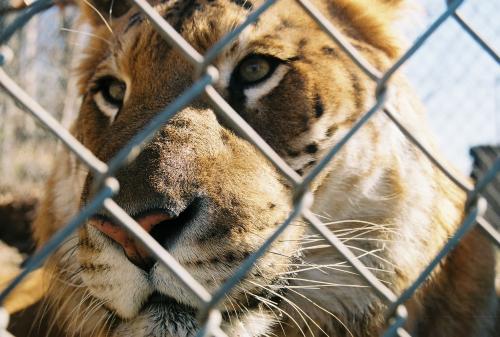
October 30, 2008
Rocky the liger, shown in this undated file photo, attacked a volunteer at a Wagoner County wildlife sanctuary Wednesday, October 29, 2008, officials said. Photo provided by The Tulsa World.
A liger is the product of crossbreeding between a male lion and a female tiger, having features of both but generally being larger than either. A tigon (sometimes written “tiglon”) is the zoo-bred offspring of a tiger and a lioness. It is only the opposite cross, of a lion and a tigress, that produces and is called a liger.
It is a lion-tiger mix (a “liger”) named Rocky that has attacked a handler, and is in today’s animal news. The unfortunate incident involves an animal known for its aggressive nature.
Authorities say a handler at a Wagoner County, Oklahoma wild animal sanctuary suffered a puncture wound to the neck after being attacked by Rocky during a feeding. Rocky is a popular resident of the attraction.
Peter Getz, 32, was bitten in the upper torso and the neck area at Safari’s Animal Sanctuary around noon on Wednesday, October 29, 2008, according to the Associated Press.
Paramedics performed CPR on Getz. Wagoner County sheriff’s deputies also responded. Getz was reportedly medivac’d to Saint John Medical Center, where he is has been listed in critical condition.
Reportedly, Getz was trying to feed the liger when it attacked him, leaving wounds on his chest and neck.
Calls to the animal sanctuary went to voicemail without ringing. The voicemail message says “a volunteer had an injury. Due to the emotional strain of the situation, Safari’s will be closed until further notice.”
The Safari’s Exotic Wildlife Sanctuary is located at 26881 East 58 Street, Broken Arrow, Oklahoma.
Safari’s Sanctuary in Broken Arrow was founded in 1995 to do just that. We rescue all kinds of wildlife, from big cats, wolves, bears, primates, hoof stock, birds, reptiles..etc. Currently housing around 200 animals. All from either private individuals who could not keep or from zoo’s that over breed. ~ Lori Ensign – President, Safari’s Inc. (shown in photos)
Dr. Kay Backues says Getz used to work with her at the Tulsa Zoo.
“He was very passionate about animals in his care,” said Backues.
She says there was always a special understanding handlers had when tending to wild animals.
“It’s important to remember they aren’t domesticated and they are wild animals,” said Backues.
“Sometimes things happen when you don’t expect it,” said neighbor Darla Adams.
Adams says she stood by with the park owner as Getz was flown to the hospital.
“I prayed with her the whole time and I was there until they left with the helicopter,” said Adams.
“It’s surprising this even happened,” said neighbor Kurt Pickering.
The park will remain closed until further notice. There is no word yet on what will be done with the liger.
In its 13 years of existence, the Safari’s Exotic Wildlife Sanctuary has not had any problems, other than five of its wolves having been poisoned to death in 2006, by someone not linked to the zoo, throwing toxic meat into their enclosure. The zoo then spent several thousand dollars to upgrade its lighting and security.
In an unrelated incident, in 2003, an animal sanctuary volunteer died when a Bengal tiger attacked her at another facility, Safari Joe’s, in Mayes County, Oklahoma.
The US Department of Agriculture monitors animal sanctuaries.
According to the Association of Zoos and Aquariums, accredited zoos frown on the practice of mixing two different species and have never bred ligers. Keeping the two species separate has always been standard procedure. However, the AZA has admitted that ligers have occurred by accident. Several AZA zoos are reported to have ligers. Safari’s Exotic Wildlife Sanctuary is not an AZA-accredited zoo. Oklahoma’s only AZA-accredited zoos are the Oklahoma City Zoological Park and the Tulsa Zoo and Living Museum.
Jungle Island in Miami is home to a liger named Hercules (shown above), the world’s largest non-obese liger, said to weigh over 1,100 lbs, over twice the size of a male lion or a male tiger. The liger is the largest animal in the cat family (Felidae).
About Loren Coleman
Loren Coleman is one of the world’s leading cryptozoologists, some say “the” leading living cryptozoologist. Certainly, he is acknowledged as the current living American researcher and writer who has most popularized cryptozoology in the late 20th and early 21st centuries.
Starting his fieldwork and investigations in 1960, after traveling and trekking extensively in pursuit of cryptozoological mysteries, Coleman began writing to share his experiences in 1969. An honorary member of Ivan T. Sanderson’s Society for the Investigation of the Unexplained in the 1970s, Coleman has been bestowed with similar honorary memberships of the North Idaho College Cryptozoology Club in 1983, and in subsequent years, that of the British Columbia Scientific Cryptozoology Club, CryptoSafari International, and other international organizations. He was also a Life Member and Benefactor of the International Society of Cryptozoology (now-defunct).
Loren Coleman’s daily blog, as a member of the Cryptomundo Team, served as an ongoing avenue of communication for the ever-growing body of cryptozoo news from 2005 through 2013. He returned as an infrequent contributor beginning Halloween week of 2015.
Coleman is the founder in 2003, and current director of the International Cryptozoology Museum in Portland, Maine.
Filed under Alien Big Cats, Breaking News, Cryptomundo Exclusive, Cryptotourism, CryptoZoo News, Mystery Cats, Weird Animal News